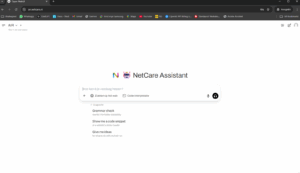
An Internal Knowledge System with AI
Do you want colleagues to get quick answers to questions about products, policies, IT, processes, or customers? Then an internal knowledge system with its own chatbot is ideal. Thanks to Retrieval-Augmented Generation (RAG), such a system is smarter than ever: employees ask questions in plain language, and the chatbot searches directly in your own documentation. This can be done completely securely, without leaking data to external parties – even if you use large language models from OpenAI or Google.
- The answer always aligns with internal reality
- No fabrications are given (as can sometimes happen with pure LLMs)
- Confidential data is never shared with the outside world
Which tools can you use?
Setting up your own knowledge system can be done with various products, depending on your preferences and requirements for privacy, scalability, and ease of use.
Chatbot and RAG frameworks
- LlamaIndex (llamaindex.ai) – Open source, broadly applicable
- Haystack (haystack.deepset.ai) – Strong in enterprise search
- LangChain (langchain.com) – Powerful for integrations and customization
- OpenWebUI (open-webui.github.io) – Simple, modern web interface for chat and management
Vector databases (for document storage and fast search)
- ChromaDB (trychroma.com)
- Weaviate (weaviate.io)
- Qdrant (qdrant.tech)
AI models
- Large models in the cloud
- Own models (on-premises or private cloud)
Important:
Many tools, including OpenWebUI and LlamaIndex, can connect both local (on-premises) and cloud models. Your documents and search queries never leave your own infrastructure, unless you want them to!
How to easily add documents
Most modern knowledge systems offer a simple upload or synchronization function.
This works as follows, for example:
- Upload your documents (PDF, Word, txt, emails, wiki pages) via the web interface (like OpenWebUI)
- Automatic processing: The tool indexes your document and makes it immediately searchable for the chatbot
- Live updates: If you add a new file, it is usually included in the answers within seconds or minutes
For advanced users:
Automatic integrations with SharePoint, Google Drive, Dropbox, or a file server are easily possible with LlamaIndex or Haystack.
Data remains secure and internal
Whether you choose your own models or large cloud models:
- You decide what goes out and what doesn’t
- Integration with Single Sign-On and access control is possible as standard
- Audit trails: who accessed what?
For sensitive information, it is advisable to use AI models on-premises or within a private cloud. But even if you use GPT-4 or Gemini, you can configure your documents never to be used as training data or permanently stored by the provider.
Example of a modern setup
With OpenWebUI, you can easily build a secure, internal knowledge system where employees can ask questions to specialized chatbots. You can upload documents, organize them by category, and let different chatbots act as experts in their own field. Read how here!
1. Adding and categorizing content
Uploading documents
- Log in to OpenWebUI via your browser.
- Go to the Documents or Knowledge Base section.
- Click Upload and select your files (PDF, Word, text, etc.).
- Tip: When uploading, add a category or label, such as “HR”, “Technology”, “Sales”, “Policy”, etc.
Advantage: By categorizing, the right chatbot (expert) can focus on relevant sources, and you will always get a suitable answer.
2. Chatbots with their own specialisms (roles)
OpenWebUI makes it possible to create multiple chatbots, each with its own specialism or role. Examples:
- HR Bot: Questions about leave, contracts, employment conditions.
- IT Support: Help with passwords, applications, hardware.
- Policy Bot: Answers about company policy and compliance.
- Sales Coach: Information about products, prices, and quotes.
Get started directly or prefer help?
Want to run a proof-of-concept quickly? With OpenWebUI and LlamaIndex, for example, you often have a demo online in an afternoon!
Want to set it up professionally, integrate it with your existing IT, or ensure it’s truly secure?
NetCare helps at every step: from selection advice to implementation, integration, and training.
Contact us for a no-obligation consultation or demo.
NetCare – Your guide to AI, knowledge, and digital security
